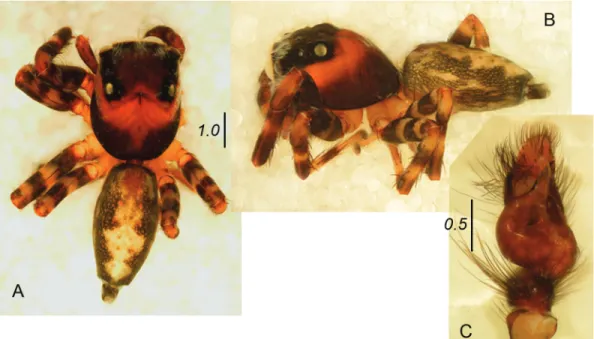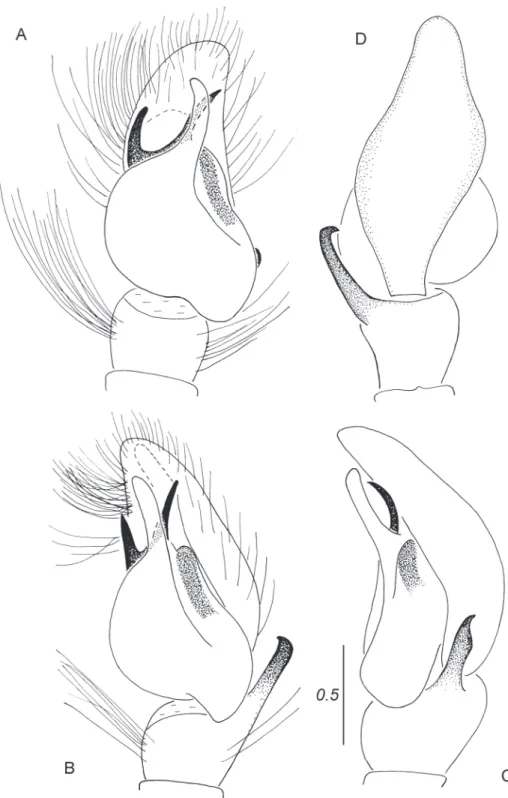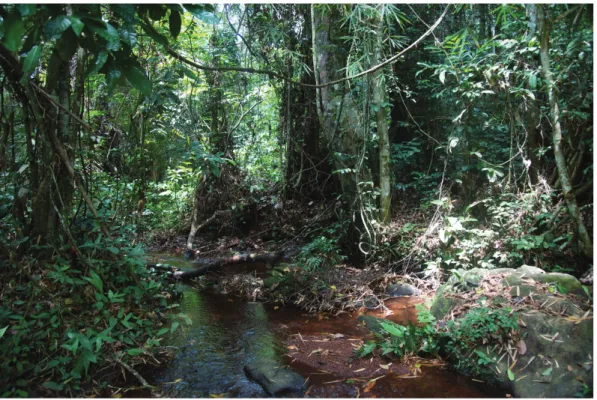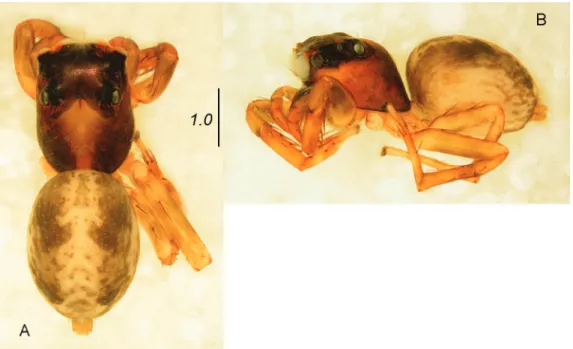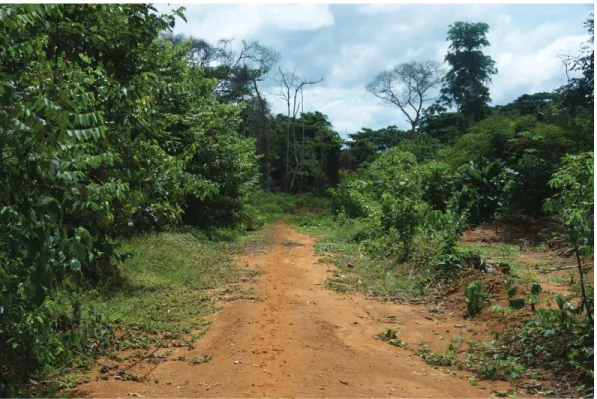Two new Thiratoscirtus species from Gabon (Araneae, Salticidae, Thiratoscirtinae)
Michael SEITER1 & Wanda WESOŁOWSKA2,*
1 Group of Arthropod Ecology and Behavior, Division of Plant Protection, Department of Crop Sciences, University of Natural Resources and Life Sciences, Peter Jordan Straße 82, 1190 Vienna,
Austria. E-mail: michael.seiter@boku.ac.at
2 Department of Biodiversity and Evolutionary Taxonomy, Wrocław University, Przybyszewskiego 63/77, 51-148 Wrocław, Poland.
* Corresponding author: tomwes@biol.uni.wroc.pl
1 urn:lsid:zoobank.org:author:457F47DC-3001-46AF-BEF4-1587BFCC9C4A
2 urn:lsid:zoobank.org:author:E362DE8A-ECB7-4C6E-B373-9E1821D214F7
Abstract. Two new species of jumping spiders, Thiratoscirtus oberleuthneri (♂) and Th. lamboji (♀), are described from Gabon, one of the least explored areas of the Afrotropics. Both species live in rainforest, at the forest fl oor. They are members of a very poorly known subfamily of salticids, the Thiratoscirtinae.
Key words. arachnology, taxonomy, Afrotropical region
Seiter M. & Wesołowska W. 2015. Two new Thiratoscirtus species from Gabon (Araneae, Salticidae, Thiratoscirtinae). European Journal of Taxonomy 123: 1–9. http://dx.doi.org/10.5852/ejt.2015.123
Introduction
Thiratoscirtinae is a subfamily of jumping spiders that has been established by Bodner & Maddison (2012) on molecular grounds. It includes a few genera distributed in Western and Central Africa. The majority of the thiratoscirtines are forest-dwellers. They have a high cephalothorax, relatively large anterior median eyes and an eye fi eld that is wider at the fi rst row of eyes than at the posterior row. Both the species affi liations and the phylogenetic relationships within this subfamily are poorly understood and require further studies.
The males of Thiratoscirtus Simon, 1886, the type genus of the subfamily, have a characteristic dense tuft of long bristles on the prolateral surface of the palpal tibia. The tarsus of the female pedipalp is armed with 1-3 spines. The diagnostic features of the genus have been summarized in Wesołowska & Russell- Smith (2011) and Wiśniewski & Wesołowska (2013). Currently, 21 species of Thiratoscirtus are known (World Spider Catalog 2014). We here provide the descriptions of two new species of Thiratoscirtus from Gabon.
Unfortunately, for each of the newly described species only one specimen of one sex was found.
Because the features of these species (especially the structure of their genitalia) are unique, their
This work is licensed under a Creative Commons Attribution 3.0 License.
R e s e a r c h a r t i c l e
urn:lsid:zoobank.org:pub:AD8BF922-4B04-4A40-880F-0787FB32913D
identifi cation will not be problematic in the future. We think, their descriptions are important due to our inadequate knowledge of the Western African salticids (Gabon is practically understudied) and our poor understanding of the thiratoscirtines. Knowledge of the subfamily will probably be essential to understanding the phylogenetic relations among jumping spiders of this part of Africa.
Material and methods
The specimens were collected by direct searching in different parts of Gabon during a fi eld trip in February 2011. For detailed information see the specifi c section below. All individuals have been stored in ethanol (70% solution). Specimens were studied and measured under a stereo microscope (Nikon SMZ1000), equipped with a camera and an ocular micrometer scale. A male pedipalp and the epigyne were dissected for a more detailed study. The epigyne was macerated in 5% hot KOH for a few minutes, dehydrated with 100% ethanol, cleared in xylene and put in eugenol in temporary mounts. After examination, the genitalia were placed in micro-vials with ethanol and stored in the vials containing the specimens from which they had been removed. Terminology is standard for Araneae. Species were measured as in Metzner (1999), dimensions are given in millimeters. Descriptions of a colour pattern are based on the alcohol-preserved specimens.
The type material is kept in the Natural History Museum of Vienna (NHMW).
Results
Class Arachnida Cuvier, 1812 Order Araneae Clerck, 1757 Family Salticidae Blackwall, 1841 Genus Thiratoscirtus Simon, 1886 Thiratoscirtus oberleuthneri sp. nov.
urn:lsid:zoobank.org:act:69137100-27F6-42ED-8FD0-65BCAA296BA3 Figs 1–3
Differential diagnosis
The male is distinctive in having a long anterior lobe of the bulb and in the presence of large terminal apophysis. An anterior lobe of the bulb is also present in T. perspicuus Wiśniewski & Wesołowska, 2013, but in the latter species it is clearly smaller and the embolus of that species is more delicate than in T. oberleuthneri sp. nov. The habitus of the newly described species is similar to that of T. torquatus Simon, 1903.
Etymology
The species name is a patronym dedicated to Anton Oberleuthner, who assisted during the fi eld trip in Gabon.
Type material Holotype
GABON: ♂, close to Midzic, 0°49.781’ N, 11°29.395’ E, 329 m a.s.l., handcatch, 10–25 Feb. 2011, leg.
M. Seiter (NHMW 21938).
Description Dimensions
Cephalothorax: length 3.3, width 2.6, height 1.8. Abdomen: length 3.4, width 1.8. Eye fi eld: length 1.5, anterior width 2.3, posterior width 2.1.
Male
General appearance as in Fig. 1A–B. Carapace oval, moderately high with gently sloping posterior part, fovea sulciform, clearly visible. Eye fi eld occupies almost half of carapace’s length, distance between anterior lateral eyes slightly larger than between posterior laterals. Ocular area dark brown, almost black near eyes, thoracic part light brown anteriorly, darkening to black at margins, striae radiating from fovea. Carapace covered with fi ne light hairs, denser and longer on anterior part of eye fi eld, a few long brown bristles near anterior row of eyes and laterally from eye fi eld. Clypeus low, brown. Chelicerae large, with two teeth on promargin and single larger tooth on retromargin. Mouth parts brown. Sternum light brown, darker at edges. Abdomen slightly elongated, narrower than carapace, blackish with mosaic of small light dots, along dorsum wide serrated yellowish white band, tinged with brown anteriorly, sigilla visible. Venter dark grey, with four lines formed by light dots. Dorsum of abdomen covered with dense short brown hairs, with admixture of white in anterior part, a few brown bristles on anterior edge.
Spinnerets black. Legs generally brown with yellowish transverse stripes: coxae and trochanters pale yellow, femora dark brown with two light rings, patellae light at base but dark distally, tibiae brown with median light ring, metatarsi as patellae, tarsi light. Hairs on legs brown. Spination of leg I: femur 0-1-1 dorsally, patella with one spine on pro- and retrolateral side, tibia 1-1 retrolaterally and 2-1-2 ventrally, metatarsus 1-1 pro- and retrolaterally and 2-2 ventrally. Pedipalp dark brown, clothed in dense long brown hairs, especially on prolateral side of tibia and prolaterally at tip of cymbium (Fig. 1C). Bulb with very long anterior membranous protuberance curtaining embolus (Figs 1C, 2A), long terminal apophysis prolaterally from embolus (Fig. 2A–B), tibial apophysis long (Fig. 2B–D), cymbium narrow (Fig. 2D).
Fig. 1. Thiratoscirtus oberleuthneri sp. nov., holotype, male. A. General appearance, dorsal view. B.
General appearance, lateral view. C. Palp, ventral view. Scale bars: A–B = 1 mm, C = 0.5 mm.
Fig. 2. Thiratoscirtus oberleuthneri sp. nov., holotype, palpal organ. A. Ventral view. B. Ventrolateral view. C. Lateral view. D. Dorsal view. Scale bar for all fi gures = 0.5 mm.
Female Unknown.
Distribution
This species is known only from the type locality in Gabon.
Habitat
The habitat is typical of a lowland rainforest in Gabon: sunlit, temperature around 33°C and high humidity. The specimen was found on the underside of a leaf in the vicinity of a small river (Fig. 3).
Thiratoscirtus lamboji sp. nov.
urn:lsid:zoobank.org:act:D14E2B1B-CFB0-4CA6-A70A-E96CB92BBB53 Figs 4–6
Differential diagnosis
The female can be recognized by the structure of the epigyne, which is similar to that in T. atakpa Wesołowska & Edwards, 2012, but differs by having clearly longer, loop-forming, seminal ducts.
Etymology
The species name is a patronym dedicated to Anton Lamboj, who assisted during the fi eld trip in Gabon and contributed by taking the habitat pictures.
Fig. 3. Natural habitat of Thiratoscirtus oberleuthneri sp. nov. in Midzic, Gabon (photo by A. Lamboj).
Material examined Holotype
GABON: ♀, 122 km south of Makokou, 0°17.213’ N, 13°14.743’ E, 500 m a.s.l., handcatch, 10–25 Feb.
2011, leg. M. Seiter (NHMW 21939).
Description Dimensions
Cephalothorax: length 2.6, width 1.8, height 1.4. Abdomen: length 2.6, width 2.2. Eye fi eld: length 1.1, anterior width 1.7, posterior width 1.5.
Male Unknown.
Female
General appearance as in Fig. 4A–B. Carapace oval, high, sloping abruptly behind eye fi eld, fovea sulciform. Distance between anterior lateral eyes slightly larger than between posterior laterals, eye fi eld black, iridescent. Thoracic part greyish brown, foveal area yellowish, yellow streak extending to posterior edge of carapace. Carapace clothed in short light hairs, denser in anterior part of eye fi eld, hairs form small patch between anterior median eyes. Reddish fawn hairs surround anterior eyes from above and form patches between median and lateral anterior eyes. Large red patches laterally from eyes of the last row made by the same hairs. Clypeus moderately high, dark. Chelicerae with two teeth on promargin and single larger tooth on retromargin, dorsal surface of chelicerae blackish. Mouth parts brown, sternum yellow. Abdomen oval, slightly swollen, greyish brown with broad serrated median streak, abdominal sides yellow marked with grey, venter whitish yellow. Dorsal surface covered with
Fig. 4. Thiratoscirtus lamboji sp. nov, holotype, female. A. General appearance, dorsal view. B. General appearance, lateral view. Scale bar for all fi gures = 1 mm.
Fig. 5. Thiratoscirtus lamboji sp. nov., holotype. A. Female palp. B. Epigyne. C. Internal structure of epigyne. Scale bar for all fi gures = 0.2 mm.
Fig. 6. Natural habitat of Thiratoscirtus lamboji sp. nov., 122 km south of Makokou, Gabon (photo by A. Lamboj).
short brown hairs. Spinnerets light. Legs yellow, fi rst pair slightly darker, femora and tibiae tinged with grey. Spination of leg I: femur with 1-1 dorsally and 0-1 prolaterally, tibia 4 pairs ventrally and 1-1-0 prolaterally, metatarsus 2 pairs ventrally (ventral spines on tibia and metatarsus long). Pedipalps yellow, with single prolateral spine and two retrolateral spines on tarsus (Fig. 5A). Epigyne large with two oval anterior depressions (Fig. 5B), partially plugged with waxy secretion, lips of the depressions strongly sclerotized. Posterior epigynal edge strongly sclerotized, with oval convex process. Seminal ducts long, forming loop, spermathecae small (Fig. 5C).
Distribution
This species is known only from the type locality in Gabon.
Habitat
The specimen was found in a sandy habitat (Fig. 6) in the vicinity of a secondary lowland rainforest. It was exposed to very high temperatures.
Discussion
Gabon belongs to the least explored areas of the Afrotropics, and the salticid fauna of this country is poorly known. Prószyński (2013) lists only 19 species from Gabon, ten of them as species inquirendae.
These fi gures rather show the degree of our ignorance, than the biological reality. Taking into account the considerable size of Gabon, its tropical localization and the fact that it remains one of the most extensively forested countries in Africa (Le Houérou 2009), the number of salticid species, that might be found there surely is much higher. The large forested areas of Gabon remain of great importance for the study of the biodiversity. Therefore, any new data on the spiders of this area are valuable.
Our paper contributes to the knowledge of thiratoscirtines of Central Africa. Despite the fact that the presented descriptions of the two species are based only on a single sex, we consider them important for further studies, and hope that data on the other sex will be supplied in the future.
There is no doubt that many more species of Thiratoscirtus will be found in Gabon since the molecular study of Bodner & Maddison (2012) mentioned no less than seven undescribed species from the country.
Acknowledgements
The fi rst author is greatly indebted to Anton Lamboj (Austria) and Anton Oberleuthner (Austria) for their assistance in the fi eld and their contribution to jumping spider fauna research. This study would not be possible without the help of Mario Freudenschuss (Austria). We would also like to thank the anonymous reviewers for their help and comments.
References
Bodner M.R. & Maddison W.P. 2012. The biogeography and age of salticid spider radiations (Araneae:
Salticidae). Molecular Phylogenetics and Evolution 65: 213–240. http://dx.doi.org/10.1016/j.
ympev.2012.06.005
Le Houérou H.N. 2009. Bioclimatology and Biogeography of Africa. Springer-Verlag, Berlin &
Heidelberg.
Metzner H. 1999. Die Springspinnen (Arachnida, Araneae, Salticidae) Griechenlands. Andrias 14:
1–279.
Prószyński J. 2013. Monograph of Salticidae (Araneae) of the World 1995-2013, online at http://www.
peckhamia.com/salticidae [accessed on 2 December 2014].
Wesołowska W. & Russell-Smith A. 2011. Jumping spiders (Araneae: Salticidae) from Southern Nigeria.
Annales Zoologici 61 (3): 553–619.
Wiśniewski K. & Wesołowska W. 2013. New Thiratoscirtus species from equatorial Africa (Araneae:
Salticidae). Genus 24 (2): 251–260.
World Spider Catalog. 2014. World Spider Catalog. Natural History Museum Bern, online at http://wsc.
nmbe.ch version 15.5 [accessed on 2 December 2014].
Manuscript received: 17 December 2014 Manuscript accepted: 13 March 2015 Published on: 18 May 2015
Topic editor: Rudy Jocqué
Desk editor: Kristiaan Hoedemakers
Printed versions of all papers are also deposited in the libraries of the institutes that are members of the EJT consortium: Muséum National d’Histoire Naturelle, Paris, France; Botanic Garden Meise, Belgium; Royal Museum for Central Africa, Tervuren, Belgium; Natural History Museum, London, United Kingdom; Royal Belgian Institute of Natural Sciences, Brussels, Belgium; Natural History Museum of Denmark, Copenhagen, Denmark.
ZOBODAT - www.zobodat.at
Zoologisch-Botanische Datenbank/Zoological-Botanical Database Digitale Literatur/Digital Literature
Zeitschrift/Journal: European Journal of Taxonomy Jahr/Year: 2015
Band/Volume: 0123
Autor(en)/Author(s): Seiter Michael, Wesolowska Wanda
Artikel/Article: Two new Thiratoscirtus species from Gabon (Araneae, Salticidae, Thiratoscirtinae) 1-9
